Last updated: December 15, 2020
Article
West Cook Inlet Bear Ecology

NPS Photo/A. Jones
Bears Oh My!
The bear’s scientific name is Ursus arctos, which embraces both brown and grizzly bears. The park conducts aerial surveys two times each summer from Tuxedni Bay to Chinitna Bay to estimate brown bear usage of salt marsh meadows. On the evening of July 15, 2020, 289 brown bears were counted, on June 27, 2019, 189 brown bears were observed, and the survey on June 30, 2018, resulted in 259 brown bears. This implies that the meadows draw a large percentage of the bear population during peak season resulting in highly localized densities. These bears are capable of coexisting together in a relatively small area because of the abundance of food found there.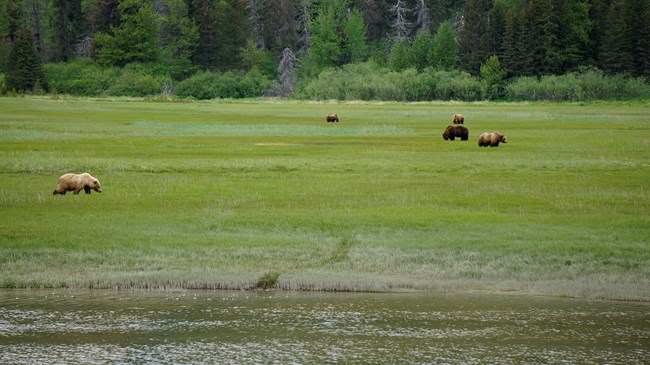
NPS Photo/D. Liles
Geographical Differences
Brown and grizzly bears are classified as the same species even though there are notable differences between them, mainly as a result of geography. Brown bears typically live along the southern coast of Alaska where they have access to unique concentrations of protein-rich foods obtained through salt-tolerant sedges, clams, and seasonally abundant spawning salmon. These foods allow brown bears to grow larger and supports higher densities than their “grizzly” cousins in the northern and interior parts of the state where food is limited.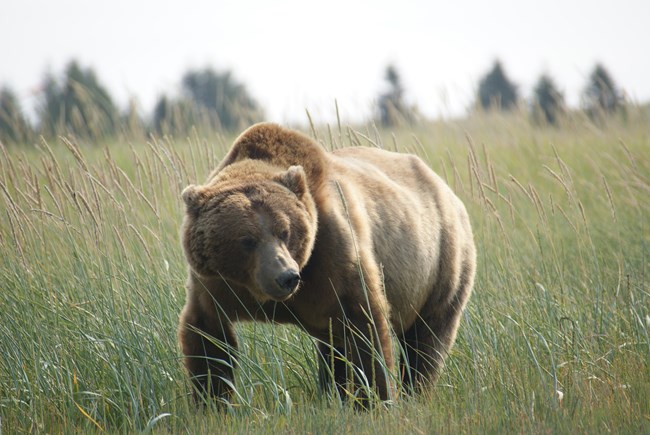
NPS Photo/A. Jones
Physical Characteristics
Coastal brown bears have a massive head, a dish-shaped or concave face, and a prominent nose allowing them to detect odors more than a mile away. They have small eyes, rounded ears, and slightly curved claws 2-4 inches long. They have the characteristic hump at the shoulders, which facilitates the bear’s ability to dig up rodents, roots, bulbs, clams, and for attaining bursts of speed up to 35-40 mph. Their hearing and eyesight are equivalent to humans. Color is not a reliable key in differentiating these bears, because they have many color phases varying from tan, blonde, gold, gray, silver, cinnamon, and all shades of brown to black.Bears are lean in the spring and early summer when they emerge from hibernation. They gain weight rapidly during late summer and fall to prepare for denning. Stores of fat will bring a male’s weight to between 500 and 900 pounds, with a weight of 1,500 pounds possible. Females commonly weigh 250 to 600 pounds in the fall. Adult brown bears stand approximately 3-5 ft. tall at the shoulder and have a body length of 5-10 ft. tall when standing on their hind legs.

NPS Photo/D. Liles
Life Cycle
Female brown bears become sexually mature at 4-6 years of age. Mating season occurs from mid-May to mid-July, potentially mating with multiple bears during the season.Females exhibit delayed implantation, which in brown bears is a period of about five months prior to den entrance. Upon entering the den, if a female does not have enough fat reserves for the winter, the embryo will not implant and will be reabsorbed. If the female is healthy, the embryo will attach itself to the uterine wall and after a gestation period of eight weeks, in January or February, the cubs will be born. A female can have a litter of 1-4 cubs, although twins are most common. They are born tiny and hairless, sometimes weighing less than half a pound. The cubs are able to move sufficiently to nurse on their mother who remains asleep. The mother’s milk is very rich (20-25% fat), allowing the cubs to gain weight quickly. Lactation usually lasts 1.5-2.5 years.
In the spring, the cubs will weigh anywhere between four and eight pounds. Male brown bears have no part in raising cubs. Cubs will stay with their mother for 2-3 years learning survival skills, at which time, the mother will leave the cubs and be ready to mate again. The average lifespan of brown bears is 15-25 years.

NPS Photo/D. Liles
Hibernation
Prior to winter sleep, brown bears increase their food consumption resulting in a surge of adipose tissue and weight gain. Adipose tissue insulates bears from the cold, provides a stored energy source during hibernation, and reduces the risk of starvation during the first few weeks of spring when they emerge from their dens.Brown bears will typically spend their winter hibernation in alpine and sub-alpine dens. They do not enter a true sense of hibernation, but rather a state of dormancy or decreased activity continuing for 3-7 months that scientists refer to as torpor. If there are large harvests of foods or winters with little snow, hibernation may be brief or may not occur at all.
Brown bears do not eat, drink, urinate, or defecate while in the den. They will undergo four physiological stages during hibernation. Their heart rate decreases from 40-50 bpm (beats per minute) in the summer to 8-10 bpm during dormancy shunting most of their blood to the heart, lungs, and brain. Their active body temperature ranges from 36.5 to 38.5 °C (97.7 to 101.3 °F) and during hibernation, their body temperature is reduced 4-5 °C. Metabolic water from fat is sufficient to meet the water demands of their body. Waste products that are normally filtered through the kidneys and excreted in the urine are recycled preventing harm to the kidneys and preserving lean body mass.
During hibernation, mature female brown bears lose about 40% (2x more than males) of their adipose tissue mass due to energy expenditure during reproduction. When bears emerge from their dens in the spring, they enter a stage of “walking hibernation” where their metabolism will stay suppressed for about two weeks. Once their metabolism increases, they will begin to search for food.
Home Range
The size of the home range of an individual brown bear will vary with the availability of high energy food sources. Along the coast, the more concentrated the food sources are, the smaller the range necessary to maintain bears. The size of home range is also influenced by age, sex, social status, condition of animal, foraging habits, location of bedding areas and dens, and proximity of mates. Females have smaller home ranges than males and tend to stay near their maternal home range increasing security for herself and her cubs. Mature males encompass home ranges of several estrous females, as larger males have greater energy needs and tend to wander farther. Subadult males tend to disperse from maternal ranges due to lower social status and aggression from adult males. Both female and male brown bears will defend their personal space, but do not normally defend their home ranges.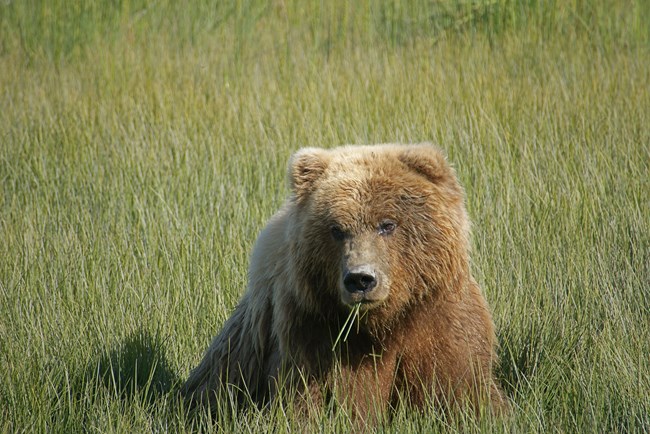
NPS Photo/A. Jones
Diet
Brown bears are omnivorous and opportunistic feeders that consume energy-maximizing diets with high nutrient content allowing them to grow and be healthy. Their diet consists of berries, flowers, grasses, herbs, roots, decaying carcasses, clams, fish, insects, moose calves, and other small mammals. Humans on Thanksgiving Day or diets of professional athletes are no match for these extreme eaters. Brown bears will consume 80 to 90 pounds of food per day in the summer and early fall. That weight is equivalent to eating a newborn calf every day. A brown bear’s diet will shift with the seasons. Spring through mid-summer, bears gather in the salt marsh meadows to feed on sedges and other salt-tolerant plants that are rich in protein to restore their depleted fat reserves. The short seasonal window of availability for plants that bears consume in these coastal wetlands can be thought of as a 24-hour salad bar where bears constantly graze like cattle in order to gain the nutrients they need to survive. Throughout the year, tidal flats are full of clams providing another source of protein until late summer, when the bears head to the river mouths to feast on spawning salmon.
NPS Photo/D. Liles
Behavior and Social Hierarchy
Salt marsh meadows are a phenomenal place to watch and learn how bears coexist together. Adult brown bears lead mostly solitary lives but are found together during mating season and where abundant food is available. Bears use vocalizations, body posturing, and scent marking to communicate with other bears. The highest-ranking brown bears are the dominant adult males (boars), then females (sows) with cubs, followed by subadults or juveniles. Weak, young, and less dominant bears yield space, breeding rights, and prime feeding locations to stronger and more dominant bears with minimal or no injury to each other. In the spring, dominant males reveal a courting behavior lasting hours or days where they will follow, chase, and strut themselves around the female.
NPS Photo/D. Liles

NPS Photo/D. Liles
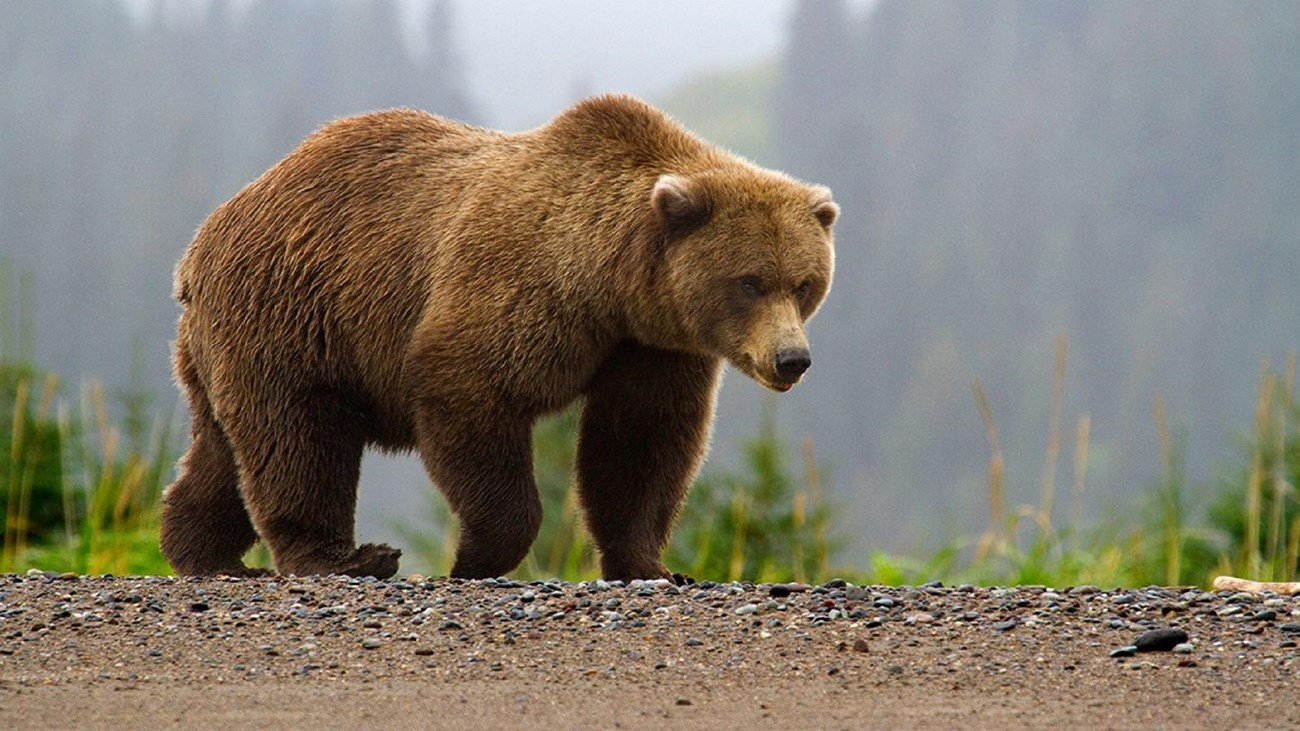
Discover how Lake Clark's coastal and inland bears differ from each-other, and learn what that means for you.
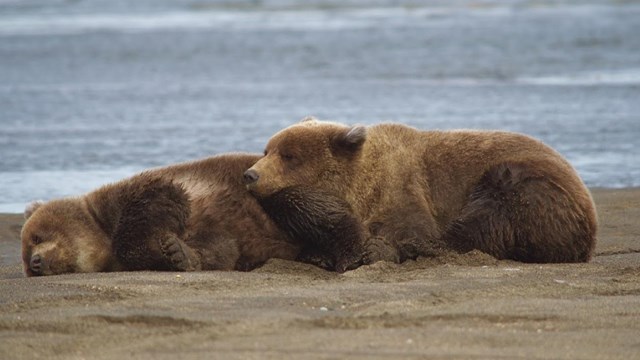
What's it like to visit world class bear viewing opportunities on the coast of Lake Clark National Park and Preserve? Find out!
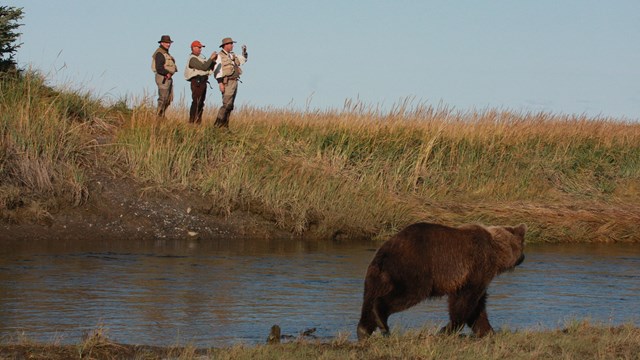
Bears and humans often frequent the same areas. Learn how to be safe around bears in Lake Clark.
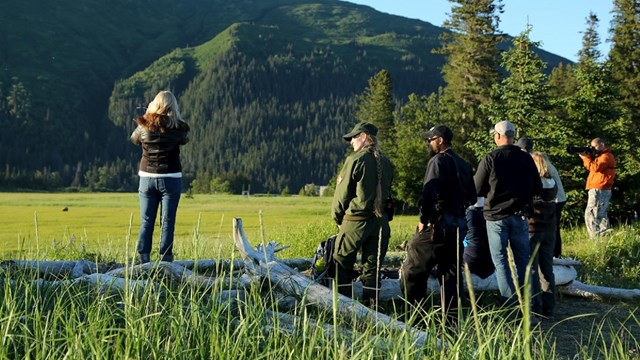
A trip to Chinitna Bay on Lake Clark's Cook Inlet coast offers a unique experience in the heart of coastal brown bear country.
